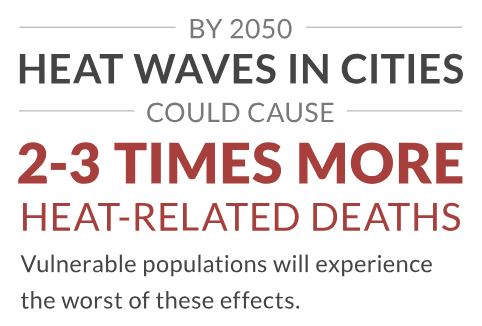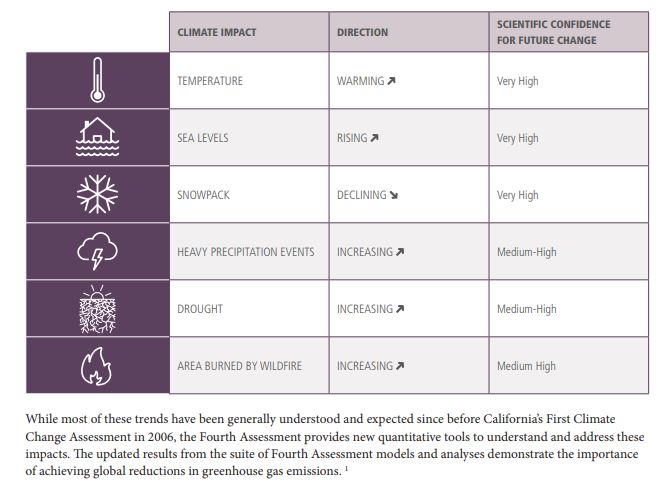Two-thirds of the beaches in Southern California could be lost to erosion, the size of wildfires in California could nearly double by 2100, and snow pack in the Sierra Nevada mountain range could decrease by two-thirds by 2050, according to California’s latest climate assessment.
At the same time, extreme heat from climate change will be especially hard on low-income communities that don’t have air-conditioning and older people who are unable to relocate to cooler areas. State and local officials, according to the assessment, must begin to address climate adaptation for vulnerable populations and promote climate justice in the state.
The new assessment, the state’s fourth since 2006 and its most recent since 2012, focuses on risk, adaptation, and resilience.
“In California, facts and science still matter,” California Gov. Jerry Brown said Monday in a statement. “These findings are profoundly serious and will continue to guide us as we confront the apocalyptic threat of irreversible climate change.”
California is one of the most “climate-challenged” regions of North America, according to the assessment. “California’s temperatures are already warming, heat waves are more frequent, and precipitation continues to be highly variable,” the researchers warn.
Since the state issued its previous assessment in 2012, California has experienced several of the most extreme natural events in its recorded history: increasingly large and severe wildfires, back-to-back years of the warmest average temperatures, and a severe drought from 2012 to 2016.
The assessment offers guidance to state and local officials for safeguarding the state from climate change. The updated climate assessment also comes at a time when the Trump administration is attempting to rescind the state’s ability to set its own automotive efficiency and emissions standards.
According to the assessment, the effects of climate change on California will increase over the coming decades in tandem with the increased urbanization of the state and economic and population growth. Fifty percent of the state’s greenhouse gas emissions come from the transportation sector.
Building in a denser way will creates less reliance on automobiles and other polluting forms of transportation, the researcher found. Denser growth also could preserve more open space and agricultural areas across the state.

One of the most visible impacts of climate change is the growing intensity and scope of wildfires in California. The area burned by wildfires in the state, for example, has increased in parallel with increasing air temperatures. Land use and development patterns will play an important role in determining how much harm to humans and damage to structures will occur due to the growing intensity of the wildfires.
The average area damaged by wildfires will increase 77 percent by 2100, according to the assessment. Without a drastic curb in the release of greenhouse gases, the frequency of extreme wildfires across the state will increase by nearly 50 percent over the next several decades, estimates the assessment.
“Available science indicates that because of climate change, many people will endure more illness and be at greater risk of early death,” the authors of the assessment explain. “Drought and wildfire, associated with climate change, present significant health and well-being risks for California populations.”
Meanwhile, sea levels along the central and southern California coast rose about six inches during the 20th century. For this century, it is virtually certain that sea levels will rise substantially; however, uncertainty persists in the rate of rise, according to the report.
Flooding from sea-level rise and coastal wave events leads to bluff, cliff, and beach erosion. Researchers found that if a 100-year storm occurs, resultant flooding in Southern California could affect 250,000 people and lead to damages of $50 billion worth of property and $39 billion worth of buildings.
Higher up, snow pack in the mountains of California and Nevada provides a natural reservoir and a key source of surface and groundwater for the state. In California, the spring snow pack stores about 70 percent as much water, on average, as the state’s engineered reservoirs.
Runoff from snow melt also contributes approximately 70 percent of total water supply in the Colorado River Basin, which supplies approximately 55 percent of Southern California’s water.
Regional analyses indicate that climate change has already begun to reduce the fraction of precipitation falling as snow in the western United States. It also has decreased spring snow water levels. Since the 1950s, April 1 snow water storage, averaged across the western U.S., has declined by about 10 percent.
“The snow loss is the result of a progressively warmer climate,” the researchers said.

While the assessment offers a wealth of information, its “key findings” are being criticized for analyzing only how climate change could impact the state, not how climate already is causing great harm. Hunter Cutting, director of strategic communications for Climate Nexus, noted that presenting nothing about the current impacts of climate change has led to holes in how the media is covering the assessment.
“Nothing about current impacts,” Cutting tweeted Monday. “Not surprisingly, that’s how the media coverage is framed, too.” This at a time while wildfires continue to burn in the west causing dangerous air quality for residents.
Deeper in the assessment, however, the researchers do offer a look at how California’s vulnerable communities are already getting hit the hardest by the impacts of climate change.
The consequences of climate-related water impacts are particularly acute for communities already dealing with a legacy of inequalities. Low-income households, people of color, and communities already burdened with environmental pollution are suffering the most severe impacts caused by water supply shortages and the rising cost of water, according to the assessment.
“Implementation of climate justice requires examining and designing processes for planning and adaptation that reflect principles of equity and inclusion from the outset, as well as considering the distribution of climate burdens and benefits,” the researchers write. “California’s adaptation policy, research, and programs emphasize ensuring that low-income and vulnerable communities are meaningfully included in plans and programs for climate adaptation plans and projects.”
Higher temperatures also will increase annual electricity demand for homes, primarily for use of air conditioning units. High demand is projected in inland regions and Southern California, according to the assessment.
With power plants one of the largest emitters of greenhouse gases, California has been aggressive in its pursuit of installing renewable energy capacity, especially solar energy, to help meet the projected growth in the use of power for air conditioning. The state is on track to meet its goal of 50 percent renewable energy by 2030.
Currently, renewables more broadly account for 27 percent of the state’s energy usage, with that total driven by a combination of solar, wind, biomass, and geothermal power.
"California keeps proving we know to invent a future few could even imagine. Now we have opportunity to take another important step forward and commit the Golden State to generating 100 percent renewable energy by 2045." – @Schwarzenegger urges #CALeg to pass #SB100 by @kdeleon pic.twitter.com/2ni8lLlKMt
— Environment California (@EnvCalifornia) August 27, 2018
California lawmakers are currently considering a bill, S.B. 100, that would set incremental clean electricity generation targets, leading up to 100 percent by 2045. The California Senate could be voting on the bill later on Tuesday.
Former California Gov. Arnold Schwarzenegger (R) wrote an open letter to state lawmakers, published in the Los Angeles Times on Tuesday, supporting the goal of generating 100 percent of its electric power needs by 2045.
“California is ground-zero for the effects of climate change,” Schwarzenegger said. “This is all happening while the occupant of the White House constantly works to fan the flames by weakening our clean energy and environmental protection policies every day. … While Washington pines for the past, we’ll be here, once again, building the future.”



